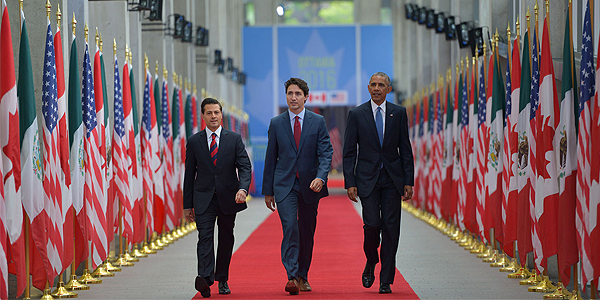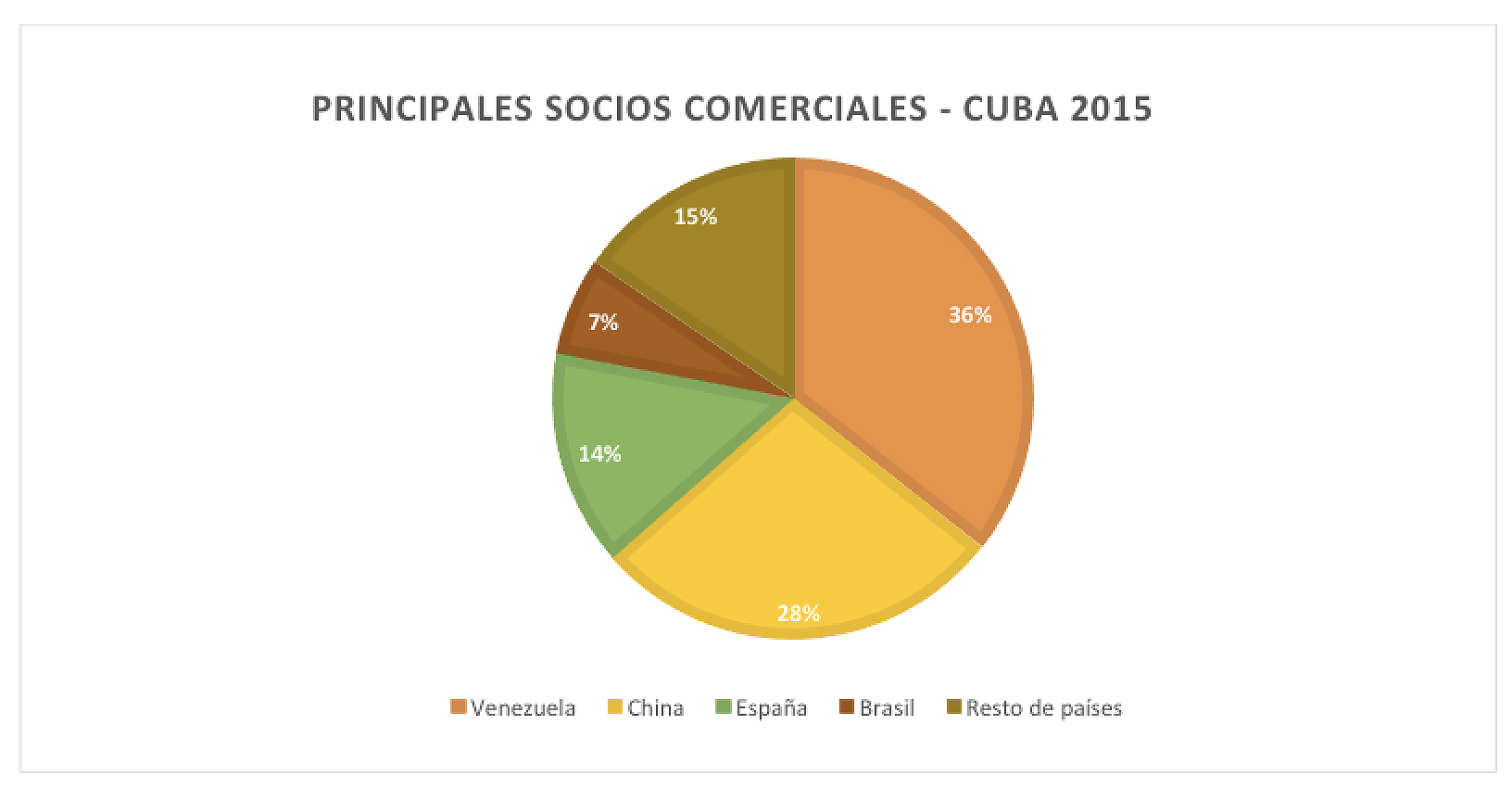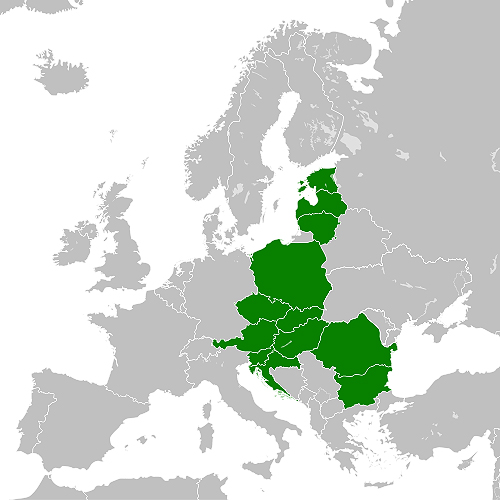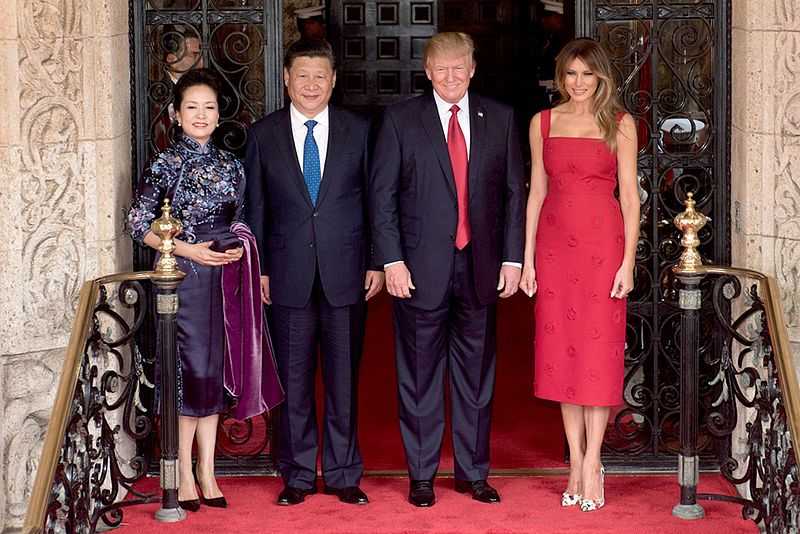Ruta de navegación
Blogs
States are torn between securing national sovereignty and cooperation between neighbours.
No other region of the world is likely to be as important a geopolitical game-changer as the Arctic. The melting ice opens up huge logistical prospects and enhances the value of territories north of the Arctic Circle because of the access they provide to untapped natural resources. Many issues are being agreed by the eight members of the Arctic committee , although of these it is Russia, Canada and the United States that are seeking to exert the most influence in the region. Let us examine the Arctic strategy being pursued by these three countries.
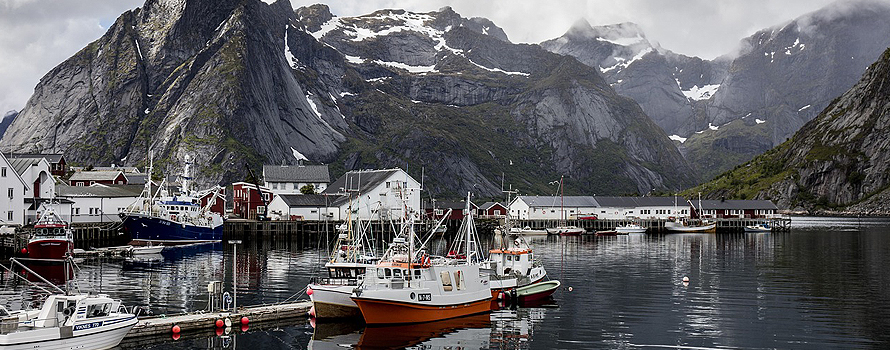
article / Martín Biera Muriel
The Arctic Circle comprises 6% of the Earth's total surface, covering 21 million square kilometres. As temperatures rise and the effects of global warming worsen, the Arctic ice sheet is shrinking, revealing an area rich in raw materials and natural resources, and increasing its strategic importance for the maritime connection between Europe and Asia. This has made the Arctic a region of great geopolitical significance in the 21st century International Office .
Agencies from various countries, such as the National Oceanic and Atmospheric Administration and the US National Snow & Ice Data Center, as well as international organisations and companies of different nationalities, point out that the ice cover on the Arctic shelf has been considerably reduced due to the consequences of climate change and rising temperatures. This allows states with sovereignty over these waters and islands easy access to the region, providing an opportunity for the exploitation of oil, natural gas, minerals, fisheries, shipping and tourism.
As early as 2008, the US Geological Survey estimated that the Arctic contained approximately 240 billion barrels of oil and natural gas, a figure that constitutes about 10 per cent of the world's existing resources; this does not take into account the amount of resources that, for practical reasons, have not yet been discovered. In total, it is estimated that undiscovered resources would comprise 16% of the world's oil reserves, 30% of the world's gas reserves and 26% of the world's natural gas reserves; about 84% of these resources are offshore. Estimates suggest that 10 trillion barrels of oil and 1.55 quadrillion cubic metres of natural gas may exist in the Arctic subsurface.
The Arctic committee
The Arctic committee , established in 1996, is a high-level intergovernmental forum for policy discussions on issues common to the governments of the Arctic states and their inhabitants. It is the only circumpolar forum for policy discussions on Arctic issues. All Arctic states are members, with the active participation of their indigenous peoples. It has eight members: Iceland, Denmark, Canada, the United States, Russia, Sweden, Norway and Finland. In terms of its functioning, it is divided into different groups of work and task forces, each of which has its own fields of action and functions. Thus, there is the Artic Contaminants Action Program (ACAP), whose function is to promote mechanisms for states to reduce pollutant emissions, or the Emergency Prevention, Preparedness and Response Working Group (EPPR), which seeks to protect the environment from possible accidental releases of pollutants. Although their presence is very limited, it is worth noting that on numerous occasions the different task forces and groups of work have managed to achieve the objectives they had planned, such as, for example, a reduction in CO2 emissions.
Of the eight countries that are part of the Arctic committee , Canada, the United States and Russia have the most influence in the region. What strategies are each of them pursuing?
Canada: more means to patrol the waters
For Canada, the Arctic is not only central to its national identity, but represents a potential for the country's future, especially in subject geopolitics. The Canadian government sees the Arctic as a area of opportunities and challenges, which it groups into four areas: exercising its sovereignty, promote the development economic and social, protecting the environment, and improving its governance in the northern regions. These four pillars of Canada's Arctic policy are manifold: resolving territorial disputes, maintaining sovereignty and security in the Arctic territory, promote the conditions for sustainable development and addressing governance of emerging issues such as public safety or pollution, among others.
Since 2007, Canada has strengthened its defence efforts to ensure sovereignty over its Arctic territory. That year it announced measures to increase its capabilities in the area, which have included the launch of the RADARSAT-2 satellite to monitor the Arctic and the deployment of 1,500 troops to patrol Arctic waters. For the latter role, icebreakers and maritime patrols have been added. The government also announced increased investment in the Canadian Ranger Corps to improve its presence in the area and to work with the North American Aerospace Defence Command to monitor Canada's northern airspace.
United States: Pentagon sets out its Arctic Strategy
US activity in the Arctic, a region to which it has belonged since the purchase of Alaska, encompasses a broad spectrum of activities, from resource extraction and trade to science and national defence operations. The strategy of the US Arctic Defence department is to maintain a secure and stable region, where US interests are safeguarded and its sovereign space protected, and where nations work together to address a range of challenges, including, most notably, climate change. The US strategy has two objectives:
-
Ensuring and supporting security and promote defence cooperation.
-
Prepare for a wide range of challenges and contingencies.
In addition, the department Defence stated in a document called Arctic Strategy that these objectives should be achieved through innovative approaches, with low budget and through multilateral exercises with other countries, such as the Search and Rescue Exercise. To achieve these goals, the Defence department set out a number of strategies: exercising sovereignty in its territory, engaging public and private sector entities to improve domain awareness in the Arctic, partnering with other Departments, agencies and nations to support human and environmental security, and so on. The department Defence, at partnership with the North American Aerospace Defense Command, developed an analysis and reporting programme to monitor regional activity and anticipate future trends so that future investments can sustain human activity in the region over time.
Russia: more coastline, greater access to resources
Russia is the polar state with the longest coastline, which gives it much greater access to certain resources, such as oil, than other countries, including Canada, which is the second most coastal polar state. In recent months Russia has seen an increase in natural resource production in the Arctic, especially hydrocarbons. It is worth noting that international sanctions over the Crimean crisis have meant a challenge for Russian production, which is why the Arctic is core topic for its development. Russia' s policy in the North Pole is based on two levels, military and defence, with the following objectives:
-
Use the resources in the region, mainly oil and gas, to promote Russia's economic development .
-
Maintain the Arctic as a zone of peace and cooperation.
-
Preserving ecology in the Arctic.
-
The northern route to be recognised as a transport route.
On the military side, the need to maintain troops in case of attack in the region continues. instructions In recent years Russia has therefore developed radar systems to monitor its domain, and has also encouraged the construction of small military airfields, ports and airfields to protect its territory. Notably, the port city of Severomorsk is home to the headquarters of the North Sea Fleet, one of the world's largest submarine fleets and the world's only nuclear Wayside Cross , called Peter the Great.
Notwithstanding this emphasis on military and defence issues, Russia also proposes the option of reaching agreements with other Arctic states, regardless of their size, to enhance cooperation.
Environment, development economic, defence
The elaboration of specific Arctic strategies by the countries present in the region shows that area is a relevant scenario for geopolitics and International Office in the 21st century. The states involved move on two levels: that of cooperation with their neighbours, in matters such as environmental protection and commitment to a sustainable economic development , and that of defence of their own interests, particularly in terms of ensuring sovereignty over their Arctic territories and preserving the rights that these may grant them in a future shared exploitation of the area .
If we look at the theories of International Office, the Arctic states play on the realist plane of taking positions vis-à-vis others, thinking about any future competition, and at the same time on the liberal plane of willingness to cooperate and jointly solve problems.
The new EU cooperation programme should lead to increased investment in security and defence.
After seven long years of hibernation, the European Union's Permanent Structured Cooperation (PESCO) was launched on 11 December, with the aim of achieving greater convergence in security and defence matters, mission statement . The initiative represents a leap forward in the process of European integration, overcoming the period of stagnation and hesitation brought about by the last economic and financial crisis.
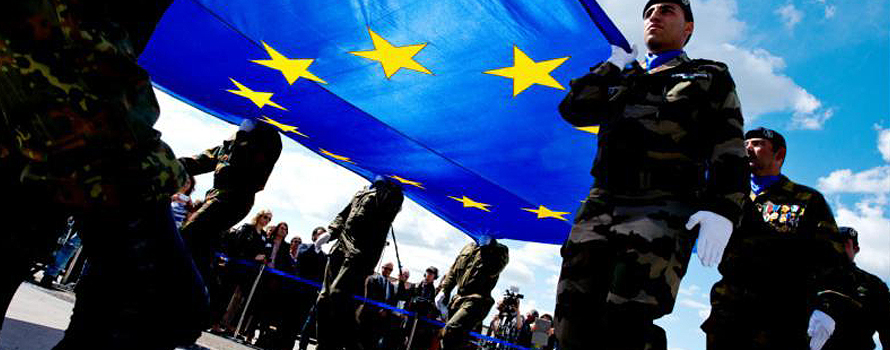
Soldiers carrying the flag of the European Union in front of the EU institutions, in 2014 [European Parliament].
article / Manuel Lamela Gallego
The very year in which the 60th anniversary of the Treaties of Rome was commemorated ended with a certain sense of vindication and reaffirmation on the part of the European Union and its member states, having succeeded against all odds in generating investment and cooperation in the areas of security and defence. The implementation of Permanent Structured Cooperation (PESCO) is the response to the urgent need for investment in these two areas, a need that the EU has had for decades and that not even the failure in the Balkans managed to address.
We speak of reaffirmation in the face of the evident crisis that the European Union has suffered in recent years, when doubts have been raised about its own continuity. Despite this delicate situation status, the EU has acted with admirable flexibility and has considered its own role on the world stage with the aim of continuing to make a positive difference in the world goal . It is in this context of reflection and change that the launch of PESCO should be framed.
To this recent loss of credibility must be added the collection of 'failures' that the EU has accumulated in generating a common defence strategy. Javier Solana's words in 2003 acknowledging the failure and fracture of the Union in the Iraq crisis management cast a shadow of impotence and ineptitude that the EU has so far been unable to shake off. area The implementation of PESCO represents a great flash of light in Europe's external action, as it demonstrates the unity within the European project in the highly sensitive area of security and defence.
In this way, and in compliance with the provisions of the Lisbon Treaty, on 13 November, and after several months of insistence by the European committee , 23 Member States signed a notification that represents the first step towards the implementation of Permanent Structured Cooperation. This moment was declared "historic" by the High Representative of the Union for Foreign Affairs and Security Policy, Federica Mogherini. This is undoubtedly a turning point in the history of the European Union, since after several decades it has managed to break with the tendency to reduce European cooperation to the sphere of economic integration. PESCO aspires to lay the foundations from which, with truly binding projects, common and shared strategies can be generated that will gradually shape the new Europe of security and defence. In its measure, Permanent Structured Cooperation is positioned like the European Coal and Steel Community (ECSC) Commission, whose decision-making dimension was one of the pillars for the expansion of European supranationalism into other, more ambitious areas.
Legal basis
The legal basis for PESCO is found in Articles 42(6) and 46, together with protocol issue 10, of the Lisbon Treaty (2009).
article 42(6): "Member States which fulfil higher military capability criteria and which have made more binding commitments on subject to perform the most demanding tasks will establish permanent structured cooperation on framework of the Union. This cooperation shall be governed by article 46 and shall not affect the provisions of article 43".
If anything should be emphasised about the Permanent Structured Cooperation it is its binding nature, whereby states will be truly bound by their commitments, as we can see from article 46(4): "If a participating Member State no longer fulfils the criteria or can no longer assume the commitments referred to in Articles 1 and 2 of the protocol on permanent structured cooperation, the committee may adopt a decision suspending the participation of that State".
PESCO's lack of influence over state sovereignty is one of its fundamental characteristics. This is clearly reflected in articles 46(5) and 46(6) of the Lisbon Treaty. The first clarifies the steps to be taken by a Member State to leave project: it need only notify committee of its intention to leave withdrawal. The second deals with decision-making within the Permanent Structured Cooperation: decisions will be taken unanimously, in a unanimity constituted by the votes of the representatives of all Member States participating in PESCO.
expense of 2% of
On 11 December, the European committee finally decided to launch PESCO, an initiative that Ireland and Portugal joined, bringing the issue membership to 25 countries. This led to the adoption of the first 17 projects on which participating states commit to cooperate and which will be formally adopted by committee in 2018. These projects will cover various areas of European security and defence, such as the training of troops or the standardisation and facilitation of cross-border military transport (the latter of which has been in high demand by NATO in recent years). In addition to this list of projects, it is worth highlighting the commitment of states to steadily and continuously increase defence budgets in real terms. After several years of economic and financial recession in most European states, defence spending falls short of the 2% of GDP agreed at the NATO summit in Wales in 2014. This is undoubtedly one of the most important tasks for PESCO to fulfil in order to continue with a stable development .
The Permanent Structured Cooperation initiative was taken by France, Germany, Spain and Italy, which confirms the functioning of the two-speed Europe, although in the end project has been joined by practically the entire Union, with the only absences being Malta, Denmark (which does not participate in European defence) and obviously the United Kingdom, which is planning to leave in March 2019. It remains to be seen whether this high participation does not jeopardise the initial ambition of project. Although the very nature of PESCO facilitates the coexistence of the two Europes as long as the minimum commitments are met.
The friction that PESCO and NATO may have or the future position that the UK will hold in European defence after its exit from the EU are other questions that PESCO raises. Only its implementation will dispel these uncertainties. Leaving these doubts aside for a moment, what can be said is that Permanent Structured Cooperation opens up a wide horizon and that it is exclusively in the hands of European citizens to take advantage of it.
As the current French Minister of Economics and Finance, Bruno le Maire, says: "Europe is not a certainty, it is a fight".
Bibliography
Council of the EU. (11 December 2017). consilium.europa.eu. Retrieved from Cooperation on subject defence: statement press
Council of the European Union (2017). Legislative acts and other instruments (PESCO), (p. 20). Brussels.
European Union (2009). Treaty of Lisbon. Lisbon, Portugal.
The Council and the High Representative of foreign affairs and security policy (2017). Notification on Permanent Structured Cooperation, (p. 10).
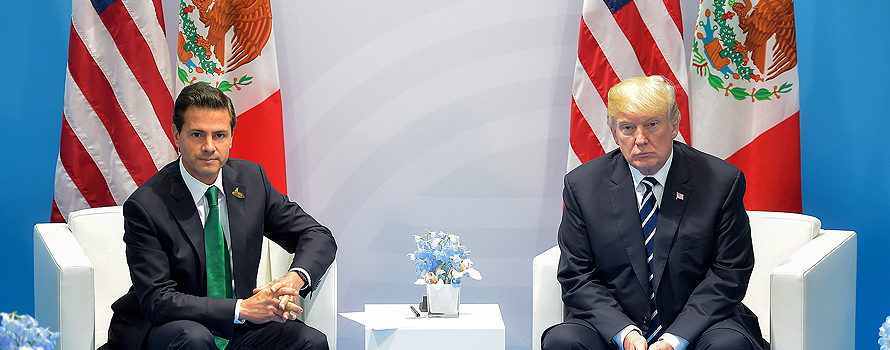
▲Presidents Enrique Peña Nieto and Donald Trump, in the latest G20 Summit; Hamburg, July 2017 [Presidency of Mexico].
ANALYSIS / Dania Del Carmen Hernández [English version] [Spanish version].
Canada, the United States and Mexico find themselves immersed in the renegotiation of the North American Free Trade Agreement (NAFTA). The trade treaty between these three countries has been controversial in the past few years, especially in the US, where many have doubted its benefits. During the presidential campaign, Donald Trump defended the complete elimination of the treaty; subsequently, when already in the White House, he agreed to make the renegotiation happen. President Trump argues that the pact has hollowed out US manufacturing and caused a trade deficit of over $60 billion with Mexico ($18 billion with Canada), so unless he can rework it in favor of the United States, he said, he won't hesitate to withdraw from it.
Overall, the American people have pretty positive views on the treaty, with 56% of the population who say that NAFTA is beneficial to the country, and just a 33% who say it's bad, according to a poll conducted by Pew Research in November 2017. Out of those who have a negative view, the majority are Republicans with 53% of them claiming Mexico benefits more, compared to Democrats who are generally more supportive of the trade pact and with just 16% who agree with the Republicans on that matter.
 |
Regardless of public acceptance, opinion on the treaty hasn't always been so dubious. When President Bill Clinton signed it into law, it was actually considered one of the first successes in his presidency. The same way globalization has liberalized trade all over the world, NAFTA effectively expanded trade and presented a great number of opportunities for the US, all while strengthening the country's economy.
Under NAFTA, US trade in goods and services with Canada and Mexico went from $337 billion in 1994 when the treaty came into force, to about $1.4 trillion in 2016. Under NAFTA, cross-border investment among the three member countries has surged as well, from $126.8 billion in 1993 to $731.3 billion in 2016.
The concern in Washington is that, despite of the increasing volume of trade, in relative terms the US isn't getting fruitful enough results, compared to what its neighbors are getting from it. In any case, Canada and Mexico accept that, almost after 25 years of validity, the agreement must be revised to be able to adapt it to the new productive and commercial conditions, defined by technological innovations that, as is with the case of the development of the internet, were not contemplated when the treaty was signed.
Round to round examination
The discussion between the three countries affects numerous aspects, but we can talk about three main blocks that have to do with certain network lines set by the different parties in the negotiation: rules of origin; the desire of the United States to end the independent system of arbitration, through which Canada and Mexico can terminate the measures that might violate the treaty (elimination of Chapter 19), and finally other proposals, perhaps less decisive but equally important, oriented towards the general wish to update the agreement.
When the negotiations started, in August 2017, the countries expressed a concern to reach a final decision in January 2018. The plan was to have six rounds of meetings. That number has been already overcome: a seventh round is happening at the end of February and there will be possibly more. As we have reached the initial deadline an examination on the state of the discussion is relevant. A good way of doing it is following the evolution of the conversations through the rounds of meetings celebrated and this way we can evaluate the results that have been registered so far.
|
Latest North America Summit, with Presidents Peña Nieto and Obama, and Prime Minister Trudeau; Canada, June 2016 [Presidency of Mexico]. |
1st Round (Washington, D.C.; August 16-20, 2017)
The first round of negotiations set the priorities for each of the three countries on the table; it served to fixate the diary of the principal issues that would be discussed later on, without going into much detail about the measures and the how- to's.
In the first place, Donald Trump had already set clear during his campaign that he considered NAFTA an unjust agreement for the United States, due to the trade deficit that the country has mostly with Mexico, and to a lesser extent, with Canada. According to the Office of the United States Trade Representative (USTR), the US went from a surplus of $1.3 billion in 1994 to a deficit of $64 billion in 2016. The major part of this deficit comes from the automotive industry. For the new administration, this puts in doubt that the treaty may have beneficial effects on American economy. Mexico, less predisposed to introduce important changes, insists that NAFTA has been good for all parties involved.
Another topic that was noted was Mexico's salary gap against the US and Canada. Mexico defends that, despite having one of the lowest minimum wages in South America, and having had their medium wage stuck during the two past decades, this shouldn't be taken into account in the negotiations, for it is estimates that Mexican salaries will eventually reach those of their commercial partners. On the contrary, for the US and Canada, this remains a matter of concern; both countries insist that a wage increase would not damage Mexican economy.
Rules of origin was one of the principal recurring topics of discussion. The United States is looking for augmentation in the percentage of content that is required to consider a product as of origin so that it won't be necessary to pay tariffs when moving it between the three countries. This proved to be rather controversial in this first round, as it could negatively affect Mexican and Canadian companies. Specialists have made the remark that a minimum of national content does not exist in any free trade treaties in the world.
Lastly, Trump's administration let their intentions of eliminating Chapter 19 show. A section of the treaty which guarantees equality in the solving of disputes between the countries, making it so that it isn't national laws what will dictate the outcome. The US understands it as a threat to their sovereignty and believes that conflicts should be resolved in a way in which their own democratic processes wont be ignored or jeopardized. For their part, Canada conditioned their permanence in the treaty with the maintenance of the chapter. Mexico also defends guarantees of independence in the resolution of conflicts even though for the moment it hasn't been categorical in this discussion, since it lingers on the side, and will act accordingly to what results most favorable.
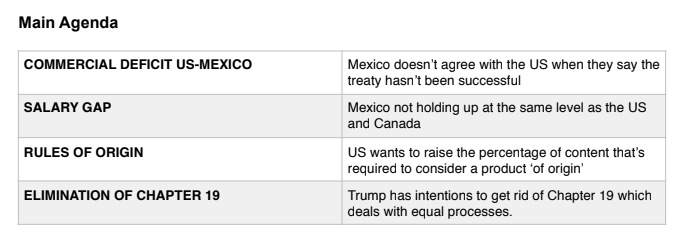 |
2nd Round (Mexico City; September 1-5, 2017)
Although considered successful by many analysts, the second round of the renegotiation followed a very slow pace. Some of the matters that made advances were: wages, access to markets, investment, investment, rules of origin, commercial facilitation, environmental issues, digital commerce, SME's, transparency, anti-corruption laws, agronomy and textiles.
The president of Corporate Coordinating Council in Mexico, Juan Pablo Castañon, insisted that for now the salary issue wasn't up for negotiation, and rejected the idea that any of the parties had the intention of pulling out of the treaty, despite the previous threats from the Trump administration. Castañon rallied in favor of Mexico supporting the maintenance of Chapter 19 or the establishment of a similar instrument with the purpose of solving commercial controversies amid the three countries.
3rd Round (Ottawa; September 23-27, 2017)
The delegates made important advances in competition policies, digital commerce, state-owned companies and telecommunications. The principal development had to do with some aspects related to SME's.
The Canadian chancellor, Chrystia Freeland, criticized that the United States had not made any written formal proposals on the most complex areas, demonstrating a passive attitude of the country in the context of the negotiation.
The US trade official, Robert Lighthizer, said that his country is interested in increasing the salaries in Mexico to avoid an unfair competence, seeing that Mexico has attracted factories and investments with their low salaries and their weak trade-union regulations.
Canada endured a firm posture on Chapter 19, which they consider one of the greatest achievements of the current agreement. "Our government is absolutely committed to defending it," said Freeland. Washington requested, though without presenting a formal proposal, the modification of the rules of origin so that they are more strict, avoiding that imports from other nations are considered "made in North America", just because they were assembled in Mexico.
This round took place while the United States fixed a tariff of almost 220% to the CSeries aircrafts by the Canadian manufacturer Bombardier, after considering that the enterprise had used a governmental subsidy to sell its plans to the United States at artificially low prices.
4th Round (Virginia; October 11-17, 2017)
The United States presented their formal proposal of elevating the rules of origin in the automobile industry and suggested introducing a termination clause in the treaty.
The US proposed raising the percentage of components of national origin from any of the three countries from 62.5% to 85% so that the production in the automobile industry can benefit from NAFTA. This way 50% of it will be American production.
It was also debated, in the interest of Washington, the weakening of the system of controversy resolution present in Chapter 19, which was done without registering an approximation of the positions.
To finish, they talked about a termination clause that would give the treaty five years of life and once that time was over, it would automatically disappear, unless, when the time came, the countries decided to renew it. This proposal received several critiques, many claiming that this could infringe the essence of the agreement and that every five years would generate uncertainty in the region, considering that it would affect the investment plans of companies.
These proposals just add to the harsh climax of the negotiation that had been present since the last round in which the US had started to defend difficult proposals like the trials for dumping (selling a product for a price below its normal price) in the imports of perishable Mexican products (tomatoes and berries, governmental and textile purchases.
5th Round (Mexico City; November 17-21, 2017)
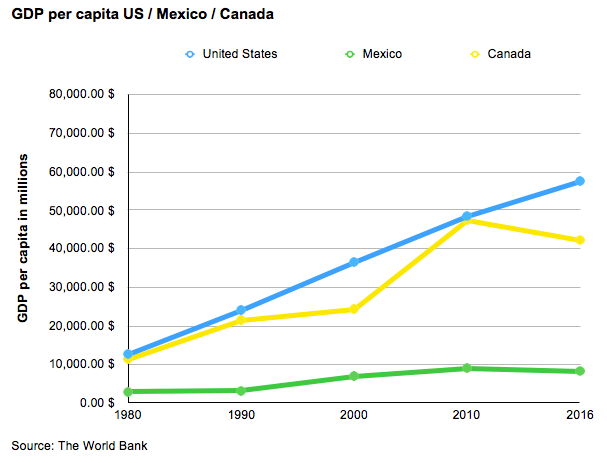 |
The fifth round didn't show too many advances. The United States kept their requests and that generated frustration amongst the representatives of Mexico and Canada.
The US didn't receive alternatives to its proposal to change the regional composition from a 62.5% to an 85%, and that at least 50% is American, On the contrary, its commercial partners showed the damage that this proposal could cause to the three economies.
Faced with the US' intentions to limit the number of concessions that their federal government offers to Mexican and Canadian enterprises, Mexican negotiators responded with a proposal to limit the country's public contracts to the number of the contracts attained by Mexican companies with other governments inside the NAFTA. Given that the number of those contracts is significantly reduced, US companies will see their contracting being restricted.
Upon completion of this fifth round, the topics that are now more developed are the ones that involve a regulatory enhancement of telecommunications and the chapter on sanitary and phytosanitary measures. With this last thing, Americans are looking to establish new transparent and non discriminatory norms, that will allow each country to establish the degree of protection they find appropriate.
6th Round (Montreal; January 23-29, 2018)
The Sixth Negotiation Round saw some progress. The chapter on corruption was finally closed, and progress was made in other fields. More importantly, we finally saw a discussion that involved some of the core issues that had been pushed back in the previous negotiations. The progression is slow, but steady.
Robert Lightizer rejected the compromise on rules of origin that Canada had previously proposed. The structure was based on the idea that the rules of origin should be calculated to also include the value of software, engineering and other high-value work, which is currently not counted toward the regional content targets. This would guarantee the safeguarding of high-paying jobs in the area. The US expressed its disapproval to the Canadian proposal. Mexico didn't find this surprising at all, as it already expected the cold shoulder from their American trade partner on this matter.
In another proposal, Canada made a threat as they claimed that they will keep the right to treat their neighbors worse than other countries if they enter into agreements. One of which could be China. The proposal was obviously not passed, as the US and presumably Mexico considered it 'unacceptable'.
Although the countries successfully worked towards installing measures against corruption during the round of negotiations, they were far from successful at reaching an agreement on the topic of modifying rules of origin and calculating the regional content of the country in which automobiles are manufactured. All three countries remain motivated to keep making progress and will resume the negotiations for a speculation of two more sessions before the deadline that has been set in March, in order to avoid interference with the presidential election in Mexico and the US midterm elections in November.
Beyond the deadline
After more than seven months of meetings, as we have seen in the round-by-round examination, the negotiations between the three countries still have not reached the pre-agreement threshold that, even waiting to resolve more or less important points, should confirm the shared will to give continuity to NAFTA. The hard positions of the United States and the pressure of Canada and Mexico to save the treaty have so far resulted in a 'tug-of-war' that has allowed some partial, but not decisive, result. Thus, it remains to be determined if the treaty has actually reached its expiration date or may be reissued instead. For the time being, the three countries agree to continue working towards a renewed treaty.
From what has been seen so far in the negotiations, it is difficult to determine which country will be more willing to give in to the pressure exerted by the others. The most controversial issues have barely been addressed until recently, so it is also not possible to point out what achievements each country achieves in this negotiating process.
The two neighbors of the United States, but especially Canada, continue to warn of Trump's risk to end the treaty. An acceleration of the negotiations could help the positive resolution of the process, but the electoral calendar rather threatens delays. On March 30 begins the campaign of the presidential elections in Mexico, which will take place on July 1. In September, the United States will begin to pay more attention to the November Mid-term elections. A substantial progress before the Mexican elections could put the agreement on track, although some issues should have to be agreed later, but if in the next meetings there is not a breakthrough, the three countries could get used to the possibility of ending NAFTA, what would harm the negotiations.

▲Enrique Peña Nieto and Donald Trump at the July 2017 G20 summit in Hamburg [Presidency of Mexico].
ANALYSIS / Dania Del Carmen Hernández [English version].
Canada, the United States and Mexico are immersed in the renegotiation of the North American Free Trade Agreement (NAFTA). The trade agreement between these three countries has been somewhat controversial in recent years, especially in the US, where its advisability has been questioned. During the presidential campaign, Donald Trump defended the cancellation of the treaty; later, already in the White House, he accepted that there would be a renegotiation. Trump argued that the pact has reduced US manufacturing jobs and generated a trade deficit of more than $60 billion with Mexico ($18 billion with Canada), so unless new conditions substantially reduced that deficit, the US would withdraw from agreement.
Overall, Americans have positive views of the treaty, with 56% of the population saying NAFTA is beneficial to the country, and 33% saying it is detrimental, from agreement with a November 2017 Pew Researchsurvey . Among those who hold a negative view, the majority are Republicans, with 53% saying Mexico benefits the most, while Democrats overwhelmingly support the pact and only 16% view it negatively.
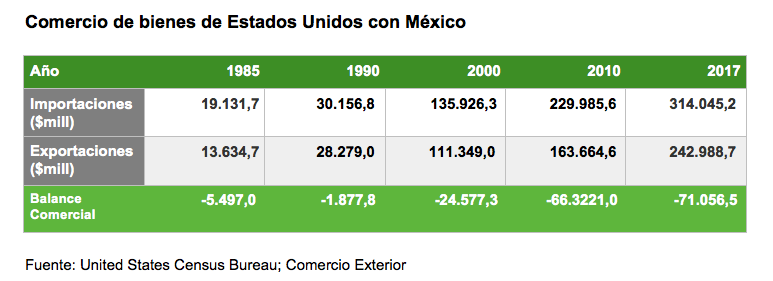 |
Regardless of public acceptance, opinion about the treaty has not always been so dubious. When President Bill Clinton ratified the treaty, it was considered one of the greatest achievements of his presidency. Just as globalization has liberalized trade around the world, NAFTA has also expanded trade very effectively and presented a great issue of opportunities for the U.S., while strengthening the U.S. Economics .
Under NAFTA, trade in U.S. goods and services with Canada and Mexico grew from $337 billion in 1994, when the treaty entered into force, to $1.4 trillion in 2016. The impact has been even greater when taking into account cross-border investments between the three countries, which went from $126.8 billion in 1993 to $731.3 billion in 2016.
Washington's concern is that, despite this increase in trade volume, in relative terms the United States is not achieving sufficiently fruitful results compared to what its neighbors are getting from the treaty. In any case, Canada and Mexico accept that, after almost 25 years in force, the treaty must be revised to adapt it to the new productive and commercial conditions, marked by technological innovations that, as is the case of the Internet development , were not contemplated when the agreement was signed.
Round-by-round examination
The discussion of the three countries touches on numerous aspects, but three blocks can be mentioned, which have to do with certain red lines set by the different parties to the negotiation: the rules of origin; the desire of the United States to end the independent arbitration system, through which Canada and Mexico have the ability to end measures that violate the trade agreement (elimination of Chapter 19), and finally proposals, perhaps less decisive but equally important, aimed at the general update of the treaty.
When negotiations began in August 2017, it was expressed that they could be concluded by January 2018, with six rounds of meetings planned. This issue is already being exceeded, with a seventh round at the end of February, possibly to be followed by others. Now that the initial deadline has been reached, however, it is time to review the status of the discussions. A good way to do this is to follow the evolution of the talks through the rounds of meetings held and thus be able to assess the results that have been recorded so far.
|
Last North American Summit, with Peña Nieto, Trudeau and Obama, held in Canada in June 2016 [Presidency of Mexico]. |
1st Round (Washington, August 16-20, 2017)
The first round of negotiations put on the table the priorities of each of the three countries; it served to set the diary of the main issues to be discussed in the future, without yet addressing concrete measures.
agreement First of all, Donald Trump already made it clear during his election campaign that he considered NAFTA to be unfair to the United States due to the trade deficit that the United States has mainly with Mexico and, to a lesser extent, with Canada.
According to figures from the Office of the US Trade Representative, the US went from a surplus of $1.3 billion in 1994 to a deficit of $64 billion in 2016. Most of this deficit comes from the automotive industry. For the new U.S. Administration, this calls into question whether the agreement will have beneficial effects for the domestic Economics . Mexico, less inclined to introduce major changes, insists that NAFTA has been good for all parties.
Another topic was the wage gap between Mexico and the United States and Canada. Mexico argues that, despite having one of the lowest minimum wages in Latin America, and having had a stagnant average wage for the last two decades, this should not be taken into account in the negotiations, as it believes that Mexican wages will gradually catch up with those of its trading partners. On the contrary, for the US and Canada it is a topic of concern; both countries warn that a wage increase would not harm the growth of the Mexican Economics .
Rules of origin was one of the main topics of discussion. The United States is seeking to increase the percentage of content required to consider a product as originating so that it is not necessary to pay tariffs when moving it between any of the three countries. This was controversial in this first round, as it could negatively affect Mexican and Canadian companies. Specialists warn that the minimum national content requirement does not exist in any free trade agreement in the world.
Finally, the Trump administration hinted at its intentions to eliminate Chapter 19, which guarantees equality in resolving disputes between countries, so that it is not the national laws of each country that resolve the conflict. The United States sees this as a threat to its sovereignty and believes that conflicts should be resolved in such a way that its own democratic processes are not ignored. Canada has conditioned its continued membership in the treaty on the maintenance of this chapter. Mexico also defends guarantees of independence in conflict resolution, although so far in this discussion it was not categorical.
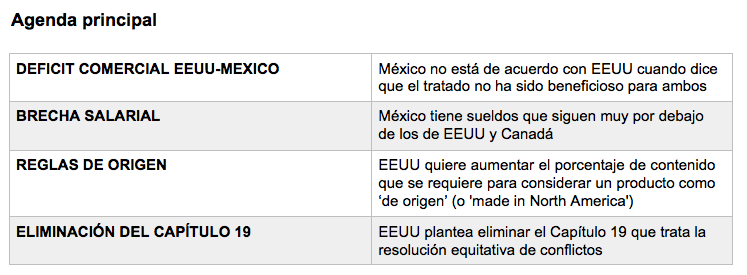 |
2nd Round (Mexico City, September 1-5, 2017)
Although considered successful by many analysts, the second round of renegotiation continued at a slow pace. Some of the issues that advanced were: wages, market access, investment, rules of origin, trade facilitation, environment, digital trade, SMEs, transparency, anti-corruption, agriculture and textiles.
The president of committee coordinator Mexican Businessmen, Juan Pablo Castañón, insisted that for the moment the wage issue was not subject to negotiation, and denied that any of the parties had any intention of leaving the treaty, despite threats to that effect from the Trump Administration. Castañón said he was in favor of Mexico supporting the maintenance of Chapter 19 or the establishment of a similar instrument for the settlement of trade disputes between the three countries.
Round 3 (Ottawa, September 23-27, 2017)
The delegates made important advances in policies on skill, digital commerce, state-owned enterprises and telecommunications. The main progress was on some aspects related to SMEs.
Canadian Foreign Minister Chrystia Freeland complained that the United States had not made any formal or written proposals in the most complex areas, which in her opinion demonstrates a passive attitude on the part of that country in the context of the negotiations.
U.S. Trade Secretary Robert Lighthizer said that his country is interested in increasing wages in Mexico, under the logic that this is unfair skill , as Mexico has attracted factories and investment with its low wages and weak union rules. However, Mexican business and union leaders are resisting such pressures.
Canada stood firm on its position on Chapter 19, which it considers one of the great achievements of the current agreement. "Our government is absolutely committed to defending it," Freeland said. Washington raised, although without presenting a formal proposal , the modification of the rules of origin to make them stricter and prevent imports from other nations from being considered "made in North America", just because they were assembled in Mexico.
This round took place as the United States slapped a tariff of nearly 220% on C Series aircraft made by Canadian aircraft manufacturer Bombardier, which it considered that business had used a government subsidy to sell its aircraft to the U.S. at artificially low prices.
Round 4 (Virginia, October 11-17, 2017)
The United States presented its formal proposal to raise the rules of origin for the automotive industry and its suggestion to introduce a sunset clause to agreement.
The United States proposed raising from 62.5% to 85% the percentage of components of national origin from one of the three countries in order for the automotive industry to benefit from NAFTA, and that 50% be of U.S. production. association The Mexican Automotive Industry Association (AMIA) rejected proposal.
Washington's interest in weakening the dispute settlement system within the treaty (Chapter 19) was also debated, without a rapprochement of positions.
Finally, there was talk of including a sunset clause, which would cause the treaty to cease to exist after five years, unless the three countries decide to renew it. This proposal was widely criticized, warning that this would go against the essence of agreement and that every five years it would generate uncertainty in the region, as it would affect the investment plans of companies.
These proposals add to the tough negotiating climate, as already in the third round the United States had begun to defend difficult proposals, on issues such as lawsuits for dumping (selling a product below its normal price) in the importation of perishable Mexican products (tomatoes and berries), government purchases and the purchase of textiles.
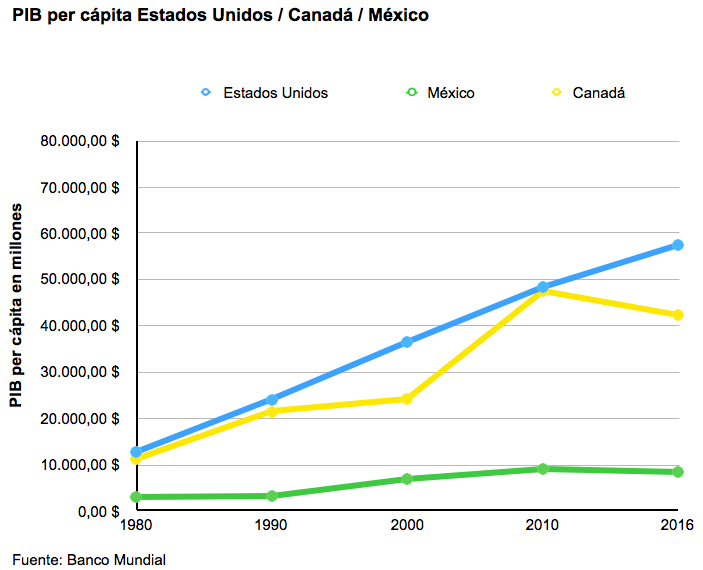 |
Round 5 (Mexico City, November 17-21, 2017)
The fifth round took place without much progress. The U.S. maintained its demands and this generated great frustration among the representatives of Mexico and Canada.
The United States received no alternatives to its proposal of wanting to increase the regional composition from 62.5% to 85%, with at least 50% being U.S.-based. On the contrary, its trading partners put on the table data showing the damage that this proposal would cause to the three economies.
Faced with the U.S. desire to limit the issue of concessions that its federal government offers to Mexican and Canadian companies, Mexican negotiators responded with a proposal to limit the country's public contracts to issue of contracts reached by Mexican companies with other governments under NAFTA. Given that the issue of these contracts is quite small, U.S. companies would be restricted in their contracting.
At the end of this fifth round, the most advanced issues are the regulatory improvement of telecommunications and the chapter on sanitary and phytosanitary measures. With the latter, the Americans seek to establish new transparent and non-discriminatory rules, allowing each country to establish the Degree protection it deems appropriate.
Round 6 (Montreal; January 23-29, 2018)
The sixth negotiation showed some progress. The chapter on corruption was finally closed, and there was progress in other areas. Some of the important issues that had been left aside in the previous negotiations were discussed. Progress is slow, but seems to be making headway.
Robert Lightizer rejected the compromise on rules of origin that Canada had previously proposed. The framework was based on the idea that rules of origin should be calculated to include the value of software, engineering and other high-value work, facets that today are not taken into account with a view to goal regional content.
As a form of pressure, Canada threatened to reserve the right to treat its neighboring countries worse than other countries if they enter into agreements. One of them could be China. The proposal was not considered, as the United States and Mexico found it unacceptable.
Beyond the deadline
After more than seven months of meetings, as reflected in this round-by-round review of the talks, the negotiations between the three countries have still not reached the threshold of a pre-agreement that, while awaiting the resolution of more or less important points, would confirm the shared will to continue NAFTA. The hard stances of the United States and the pressure from Canada and Mexico to save the treaty have so far resulted in a "tug of war" that has allowed some partial, but not decisive result . Thus, it is yet to be determined whether the treaty has actually reached its expiration date or whether it can be reissued. For the time being, the three countries are at agreement working towards a renewed treaty.
From what has been seen so far in the negotiations, it is difficult to determine which country will be more willing to yield to the pressure exerted by the others. The most controversial issues have hardly been addressed until recently, so it is not possible to say what each country has achieved in this negotiation process.
The two neighbors of the United States, but especially Canada, continue to warn of the risk of Trump wanting to kill the treaty. An acceleration of the negotiations could help the positive resolution of the process, but the electoral calendar rather threatens postponements. On March 30, campaigning begins for Mexico's presidential election, which will take place on July 1. In September, the U.S. will begin to look more closely at the November congressional elections. A substantial breakthrough before the Mexican presidential elections could put agreement back on track, even if some issues remain to be closed, but if no breakthrough is made in the next meetings, the three countries could be getting used to the idea of the end of NAFTA, which would weigh down the negotiations.
ESSAY / Martín Villegas Jordán
The concept of humanity is a contemporary idea that took shape just recently. Many say that it took place after the conference of Yalta in 1945[1]. In other words, this concept was beginning to be conceived by one of the three leaders that shaped today's world, U.S. President Franklin D. Roosevelt. During the conference, the three big leaders of the world, who at the time were British Prime Minister Winston Churchill, Soviet Premier Joseph Stalin, and U.S. President Roosevelt[2], came to an agreement (mostly encouraged by Roosevelt) that would eventually give birth to the United Nations. Now it's vital to know that this intergovernmental organization is intricately composed of the idea of a global union.
Moreover, the concept of a global union, of the United Nations, embodies the idea of humanity as universal. It encompasses the idea of humanity as a composition of every existing nation. In short, humanity eventually becomes the nation for all human beings, a nation of nations. And this is where Mr. Roosevelt plays a relevant role when he said: "A nation that destroys its soils destroys itself. Forests are the lungs of our land, purifying the air and giving fresh strength to our people"[3].
It's possible, then to say that the previous century was the time when global issues were given the attention that they deserved. For instance, the National Aeronautics and Space Administration (NASA) marks 407.62 parts per million of carbon dioxide of earth and 0.99 degrees Celsius for the temperature anomaly of 2016 (denoting that year as one of the sixteen warmest years since 2001)[4].
Besides, humanity faces dramatic gaps in temperature. Take a look, for instance, at Oymyakon, Russia, where the temperature is normally around negative fifty-four degrees Celsius[5]. Now, looking at the Sahara desert, it's inhabitants face temperatures of fifty-nine degrees Celsius or more.
Moreover, climate change becomes a more pressing matter when looking at two reports of the NASA. On the first hand, the one titled "November of 2017 was the third warmest November on record" states: "The last three Novembers — 2015, 2016, and 2017 — are the three warmest in the entire modern record." [6]. On the other hand, the one titled "Greenland melt speeds East Coast sea level rise" states the following: "the Greenland and Antarctic influence alone would account for an increase in the rate of sea level rise on the East Coast of 0.0016 to 0.0059 inches (0.04 to 0.15 millimeters) each year, varying by location. That's equivalent to 7.8 inches (0.2 meters) of sea-level rise on the northern East Coast over the next century, and 2.5 feet (0.75 meters) in the south, though the estimates are quantitative and not an attempt at an actual projection"[7].
Still, having such a clear evidence of climate change, it is true that legislators choose to deny this, which actually ends up convincing people. This is evident, for example, when analyzing the politics of the current President of the U.S., Donald Trump. For instance, during his campaign (when addressing the mining community) he said: "If I take hairspray, and I spread it in my apartment, which is all sealed, you are telling me that affects the ozone layer. I say "no way folks" (...) that is like all of the rules and regulations you people have in mines"[8].
What is also true about this blind humanity is that the many pronunciations of the United States' president have a strong pull towards decisions that countries in Mesoamerica and South America take. Take Colombia, for instance. Now, this country had banned the eradication of illicit cultivations of drugs by aspartame but president Trump has been insisting and pushing for this harmful way for the environment and for humans that can possibly live by the crops[9]. Furthermore, it can be said that pressure from the North American country has not been light in the rest of Latin America.
Summing up, it is clear that America is clearly in need of renewable energy sources no matter what the political discourse states. Specifically, America is in need of "those sources of energy obtained from natural means that are renewable and susceptible to indefinite use"[10]. Take, for instance, countries like Brazil, Mexico and Argentina, which are called to be the future in the study of sustainability due to their "geographical and climatological conditions, which make Latin America one of the regions that pose high potential from renewable energy sources"[11]. Furthermore, these countries are pioneer in the ambits of wind, hydropower, and large-scale soy growing, which makes them subject to the advantages that the implementation of renewable energy poses. In fact, experts Emma Mendoza and Vadim Pérez at the University of Chile insist on these advantages being: (1) the potential for creating almost six times of what global consumption is today (2) the production being national (3) the de-centralized consumption, meaning that energy is consumed in the place where it is produced and there is no necessity to export (4) the hygiene of the obtained energy, meaning that there are no significantly harmful remnants (5) and the investment in high tech industry[12].
In fact, in America there has been an exponential growth in the implementation of renewable energy projects since the implementation of the Paris 2015 accords on Climate Change. Such growth though, is directly proportional with the increments in federal or particular centralized companies with strong governmental support [13].
In Latin America the three pillars in the ambit of sustainability are the eolian industry, the hydroelectric industry, and the industry of the monocultures[14]. Of the countries previously mentioned, for example, Brazil and Mexico specialize in the eolian industry, Brazil also plays an important role in hydropower development, and Argentina leads the large scale soy growing. It is of vast importance though, to previously mention the fact that the development of renewable energies is not the only factor that is taken into account when analyzing the partner-scientific field of sustainable energies. Then, in addition to the plain development of these energies, the social movements that emerge in response to the expansion of these industries play a key role for the future of sustainable energies in the world.
It is interesting to look at each of the fields with important developments in America. Firstly, taking a close look at how the wind power is transformed in renewable energy and the toll that it has within a partner-Economic Sphere. Now, this type of energy is the least efficient between the three types analyzed in this paper because it has the least impact on the environment and on society. However, the two countries that contribute primarily are Brazil and Mexico, respectively, with a generation of 256 MW and 88 MW[15]. Mainly, the power generated in each country is based upon eolian parks built on the appropriate territories. For example, Brazil's main park is found in the municipality of Osório and it includes three projects that sum a generation potential of 150 MW. Unfortunately, the social outcome of eolian implementation has been negative. Experts Mendoza and Pérez state that the probable origin for the social unrest is the government for ignoring the process of negotiation between enterprises and local habitants. Also, the clean energy enterprises are paying only 1.5% of the incomes to the landowners that put their terrains for the disposition of these enterprises. Besides, other social unrest is the co-ownership of most of the terrains, presenting more negotiation difficulties between enterprises and landowners. In short, the main opponents (via judicial demands) in Mexico are: "the Union of Indigenous Communities of the Northern Zone of the Isthmus" and "the Topeyec and Gubiña Human Rights Centers"[16]. As if there was not enough opposition already, these denunciators even claim that some of the acts committed by the enterprises are unconstitutional.
Secondly, it is important to look at hydroelectric power principally developed in Brazil because hydroelectricity is the principal source of electricity generation in Latin America. For example, Brazil's hydroelectric power in 2006 accounted for 60% of the total of electricity generated. Furthermore, hydroelectricity can be developed under low costs of operation and high efficacy. It is also important to look at hydroelectric power in Brazil as a pioneer due to the first efforts of implementation that have been present in the country since 1970.
Thirdly, the large-scale soy production can also be considered as a renewable energy source.
[1] History.com Staff. "Yalta Conference." History.com, A&E Television Networks, 2009, www.history.com/topics/world-war-ii/yalta-conference.
[2] Ibid.
[3] "151 Inspiring Environmental Quotes." Conserve Energy Future, 15 Apr. 2017, www.conserve-energy-future.com/inspiring-environmental-quotes.php.
[4] "Global Climate Change." NASA, NASA, 2 June 2014, climate.nasa.gov/.
[5] "Oymyakon, Russia Weather Forecast and Weather Conditions - The Weather Channel." The Weather Channel, 19 Jan. 2018, weather.com/es-ES/tiempo/hoy/l/63.46,142.77.
[6] "November 2017 Was the Third Warmest November on Record." NASA, NASA, 18 Dec. 2017, climate.nasa.gov/news/2666/november-2017-was-the-third-warmest-november-on-record/.
[7] "Greenland Melt Speeds East Coast Sea Level Rise." NASA, NASA, 13 Nov. 2017, climate.nasa.gov/news/2651/greenland-melt-speeds-east-coast-sea-level-rise/.
[8] Mischegoss. "Donald Trump Talks Hairspray and Ozone." YouTube, YouTube, 5 May 2016, www.youtube.com/watch?v=eU2p6YakNJg.
[9] Cosoy, Natalio. "Astonishment In Colombia By Donald Trump's Threat To Increase In Coca Cultivation - BBC Mundo." BBC News, BBC, 14 Sept. 2017, www.bbc.com/mundo/noticias-america-latina-41275301.
[10] Mendoza, Emma and Pérez, Vadim. Renewable Energy and Social Movements in Latin America. Institute of programs of study International – Universidad de Chile. 2010.
[11] Ibid.
[12] Ibid.
[13] Ibid.
[14] For more information of the forms of renewable energy consult: "Renewable Energy Explained." Renewable Energy Sources - Energy Explained, Your Guide To Understanding Energy - Energy Information Administration, U.S. Energy Information Administration, 1 June 2017, www.eia.gov/energyexplained/?page=renewable_home.
[15] MW means mega watts. For more information go to the following citation: -guide-
[16] Mendoza, Emma and Pérez, Vadim. Renewable Energy and Social Movements in Latin America. Institute of programs of study International – Universidad de Chile. 2010.
Examination of the reformulation of Castro's economic model attempted by Fidel's successor
Next April, a year and a half after Fidel Castro's death, his brother Raúl plans to leave the presidency of Cuba, where he has been for a decade. His bequest is an attempt to lengthen the Castro regime by forcing the island's economic recovery. But the restrictions of the reforms themselves, the slow pace of their implementation and the fact that they are not accompanied by greater political freedom, have limited the effect of the changes. Nevertheless, they may be a good starting point for the next president if he really wants to move towards full openness.

article / Valeria Vásquez
Raúl Castro replaced his brother Fidel as president of Cuba's state committee in 2008. Since then, the island has undergone changes in its organisation, although without abandoning its communist structure or the revolutionary principles set in motion in 1959. On coming to power, Castro decided to embark on a path of structural reforms in order to "update" Cuba's socio-economic model and emerge from the serious economic crisis.
As part of this programme, Raúl Castro approved a series of social and economic reforms of a "transformative" nature, which tended towards the introduction of market mechanisms, while maintaining adherence to socialist principles based on centralised planning (and without accompanying these changes with political liberalisation). Revitalisation was the main goal of the reforms in the economic sphere, turning around what had been a fully socialist approach policy and rejecting free market reforms.
Ten years after the changeover between the Castros brothers, the Cuban regime is preparing for the arrival in April of the first president from outside the family. Although it has not yet been confirmed who the new president will be, it is expected that the current vice-president, Miguel Díaz-Canel, will be appointed as part of a continuity of power.
The country is currently at a disadvantageous status , with political uncertainty over the new phase that is opening up, the serious economic difficulties that Venezuela (the island's main benefactor for more than a decade) is going through, and the truncated foreign expectations that the arrival of Donald Trump in the White House a year ago brought with it.
update from model economic
Since 1959, Cuba's economic model has been based on revolutionary socialist principles. Since Raúl Castro came to power, however, a process of transformation has been undertaken, considered necessary to move forward a Economics that was stagnating and immersed in a serious crisis.
In reality, there was no substantial modification of the economic model , but rather a update of it, maintaining the predominance of central state planning and state ownership over the laws of the free market. The goal of this process has been to guarantee the continuity and irreversibility of socialism, as the Cuban authorities have declared, as well as to promote the country's economic development and improve the standard of living of the population.
The framework reforms were approved at the VI congress of the Cuban Communist Party, held in 2011. Among other points, the approved agreements established the submission of a usufruct to peasants and cooperatives, and opened the door to the mass dismissal of hundreds of state employees. The reform guidelines, however, did not set out the specific role that the state and state-owned sector should play in the Economics.
The so-called update of Cuba's model has led to the expansion of the market and non-state ownership, but in a Economics that is still conditioned by state planning this measure is still inefficient, as it was in China or Vietnam. While the state business still prevails (in a more decentralised form, through self-financing and without fiscal subsidies), the private sector has become more flexible, but heavy taxation of the private sector still hampers development.
Land in usufruct
One of the main pillars of the Castro government's reforms was the submission usufruct of idle state land to peasants and cooperatives, with the purpose aim of reducing imports and increasing production. The usufructuaries have obtained the right to cultivate the land and to keep what they harvest, but the state retains ownership and can terminate the contract for reasons of public interest.
Regulation was carried out through two laws: a first, in 2008, subject to many restrictions and actually disadvantageous for farmers; and a second, in 2012, more flexible, whereby the government expanded the size of the plot (from 13 to 67 hectares), approved the planting of orchards and forests, and also allowed the construction of houses next to the land (previously forbidden).
In March 2011, the government reported that 128,000 usufructs, totalling 1.2 million hectares, had already been handed over. However, although the 2012 law was less restrictive than the previous one, as mentioned above, it still included certain hurdles that discouraged farmers from getting involved: farmers made gains, but only after overcoming various obstacles.
Mass dismissal of civil servants and self-employment
At the beginning of 2011, the state payroll presented an "inflated" rate, with millions of state employees in precarious positions and conditions at work . For this reason, Raúl Castro promoted the dismissal of 500,000 surplus state workers between October 2010 and March 2011, which raised the unemployment rate to 12%. To counteract this measure, 250,000 self-employed jobs were initially created and other private activities were also promoted.
This was necessary to raise labour productivity, reduce costs and increase wages. The agreements of the CCP's VI congress allowed for the approval of 178 self-employed activities: many of them were very specific and unskilled (such as forklift drivers or bath attendants), and a few were skilled (such as translators or insurance agents). This made the private work more flexible.
Thus, in a country with a labour force of 5 million people, out of the total of 11.2 million people living on the island, a total of 4.2 million of those working are state employees and the rest are in the non-state sector, consisting of agricultural cooperatives, private farmers and the self-employed [1]. The latter now number 500,000 people. Despite this development of what is known in Cuba as "cuestapropismo", there are restrictions that prevent most professionals from working on their own in their profession, and this reduces the human capital available to boost the country's Economics .
Openness to foreign investment
The flow of investment from abroad has not accompanied the reforms promoted by Raúl Castro, which has been one of the biggest obstacles to the desired success. In order to attract foreign investment, the Special Zone of development Mariel (ZEDM) was inaugurated in 2013. The port of Mariel, located 45 kilometres west of Havana, was allocated a 465.4 square kilometre industrial zone and an advanced ship terminal. entrance The purpose was to convert the ZEDM, through the existence of incentives to attract investment, into the main gateway for foreign trade and the largest industrial structure in Cuba [2]. However, four years after its inauguration, the results have not been as expected. In an administrative process that has followed an extraordinarily slow pace, today only 33 companies have been set up at C , a far cry from the 2.5 billion dollars that the ZEDM was intended to attract annually.
The restoration of diplomatic relations with Washington at the end of the Obama administration has not accelerated investment from the US or other Western countries. In addition to the US embargo remaining in place, the Trump administration has reversed provisions passed by his predecessor that opened a timid door to greater economic engagement.
status economic
Raúl Castro's reform plan has not been as successful as expected, mainly because of the restrictive Degree that regulates them. The lack of the intended economic revitalisation has manifested itself in the poor performance of Cuba's Economics in recent years. In 2016, Cuba fell into recession, with an economic decline of 0.9%. In 2017, it was able to recover slightly (figures that have not yet been finalised speak of a 1.6% increase in GDP) thanks to a boom in tourism and better agricultural results.
In the last decade, tourism has been precisely one of the assets of the Cuban Economics . agreement According to an ECLACreport , tourism to the island grew by 11.9% in 2017, with 4.7 million visitors. This increase accounts for the largest issue of visits from the United States, made possible by the elimination of restrictions approved by Obama, but which Trump has reimposed.
On the other hand, Cuba maintains its chronic trade deficit. Although in 2016 it managed to reduce it to 9.6 per cent of GDP, the outlook is not good, given Venezuela's difficulties in continuing to supply oil, practically on a non-repayable basis. In 2015, Venezuela was Cuba's main trade partner , with which it maintains 36% of its foreign trade, in a exchange valued at 4 billion dollars. It is followed by China, with 28%, a country that sells under soft credit conditions to the island.
|
sourceSOURCE: ONEI. yearbook Estadístico de Cuba 2015, external sector. |
bequest and new challenges
As Raúl Castro's presidency draws to a close, Cuba finds itself in an unfavourable status , with a Economics that is struggling to emerge from stagnation and with a programme of structural reforms that have been insufficient to resolve the problems accumulated over more than 60 years of centralised state socialism. partner-economic problems. The timid nature and slow pace of economic reforms have not helped to revive Economics.
However, during his decade in power, Castro has led changes in the management of model, something that should be taken into account even though in the political sphere he has perpetuated the lack of freedom and the persecution of opposition activity, without undervaluing the moral guilt of the dictatorship. Among the changes that have taken place are the opening up to foreign investment, new diplomatic relations, participation in Latin American forums and the immersion of Cubans in work on their own account.
Probably forced by circumstances, Raúl Castro was able to break down some of the obstacles and ideological barriers that his brother Fidel had implemented on the island for more than 40 years in power. The outgoing president's bequest marks some progress, but it will be the actions of the incoming president that will indicate whether Cuba is truly moving towards the economic - and political - opening that Cubans have longed for.
[1] VIDAL, P. and PÉREZ Villanueva, Omar E. "Se extiende el cuentrapropismo en Cuba". Espacio Laical, vol. 6, n. 3 (2010), p. 53-58.
[2] HERSHBERG, E., & LEOGRANDE, W. M. (2016). A new chapter in US-Cuba relations: social, political, and economic implications. New York: Palgrave Macmillan.
[Riordan Roett, Guadalupe Paz (Eds.). Latin America and the Asian Giants: Evolving Ties with China and India. Brookings Institution Press, 2016, 336 pages]
review / Ignacio Urbasos Arbeloa
Trade between Latin America and the Asia-Pacific region has grown over the last decade at a dizzying rate of 21% per year[1]. However, China's prominence has overshadowed and concentrated the vast majority of academic analyses, leaving other relevant actors such as India in the background. This book by Riordan Roett, Guadalupe Paz and other collaborators from different parts of the world offers an interesting comparison between the two "Asian giants" in their relations with Latin American countries in a new global context. This review, will focus on India's rise in the region, although references to China are inescapable.
Historical ties between Latin America and India, though weak, have existed since the colonial period. Today, one million people[2] descendants of Indian migrants live in the Caribbean, a fact that can be considered an opportunity to generate channels of dialogue, however the magnitude of the Indian diaspora eliminates any trace of exceptionality. Another interesting element directly links India and Brazil, two countries that share to some extent the bequest They have been champions of South-South cooperation to this day, an approach shared by Lula and Dilma as well as Modi. In the section historically, India's relevance is much greater than that of China, which lacks relevant references partner-cultural activities in the region.
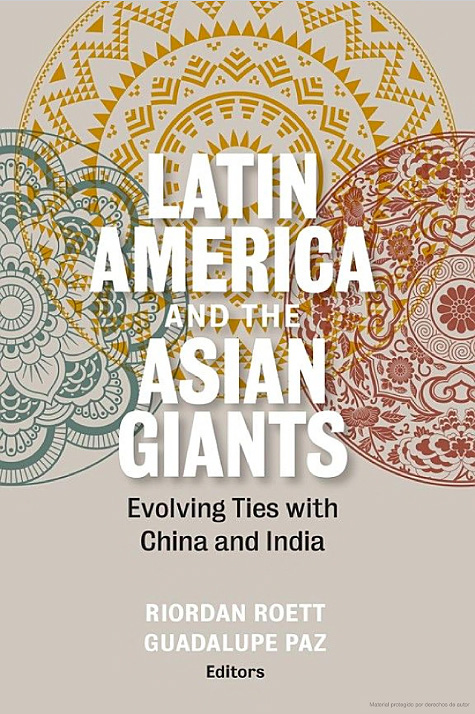 |
The growing economic presence of the two Asian giants in Latin America has not gone unnoticed in the discussion politician. Historically, left-wing sectors have been more supportive of increasing trade relations with China, considering it a way to achieve the continent's emancipation and independence from the United States. The right, on the other hand, has been reluctant to have a greater presence of China, aligning itself in the case of the countries of the Pacific Alliance with the TPP, which until the arrival of Trump was intended to be a free trade agreement aimed at increasing the presence of the American continent in the Asia-Pacific outside of China[3]. In the authors' opinion, Latin America lacks a cohesive narrative and strategy on China, thus drastically reducing its negotiating capacity and influence over the Asian country. The case of India is different, as the volume of trade is still a tenth that of China, being a democratic country, an ally of the US and with a better image on the continent.
Despite the fact that the vast majority of Latin American exports to Asia are made up of commodities and imports are made up of manufactured products, there are subtle differences that explain India's better image in the region. First, Chinese imports are much more diversified than Indian imports, generating a general perception of destruction of the industrial fabric and local jobs due to greater competitiveness due to economies of scale and the distortion of the yuan. Likewise, what India exports to Latin America are socially valued products (such as generic drugs, which have reduced the price of medicines) and cheap vehicles, while Indian businessmen set up information companies, which have generated 20,000 jobs in the region.
In terms of imports, both India and China concentrate their purchases on natural products. profile India's most energetic and China's most mining. Both countries concentrate a huge demand for soybeans, a product that agreement with Riordan Roett it will gradually become increasingly important due to its versatility as a feed, feed and biofuel source. It is important to note that Latin America is one of the keys to the energy and food security of these countries, which are facing this enormous challenge The size of its population is derived differently: India is betting on private investment and China on long-term purchase agreements for its state-owned companies. A possible collision between the two Asian giants for access to these markets cannot be ruled out, with the geopolitical implications that this entails.
In terms of India's financial positioning in Latin America, the reality of the sample an almost testimonial presence compared to that of China. However, it should be noted that Indian investment and loans are viewed much better than Chinese ones. Overall, India acts as a partner This is not the case with China, whose actors are more accustomed to dealing with a complex bureaucracy than with a democratic system. Likewise, Chinese loans, increasingly present in certain economies such as Venezuela or Ecuador, have proven to be less advantageous than those of international organizations such as the IMF or IDB as they have higher interest rates and are linked to strict conditions for the purchase of goods. All of this makes India a partner friendlier to the public: a challenge that it will have to face as its presence in the region increases and with it its true way of acting abroad can be appreciated, still an unknown.
In final, India's role in the region is promising but still limited in scope. The annual growth of trade between that country and Latin America was 140% between 2009-2014[4] and India has already signed the first free trade agreements (with MERCOSUR and Chile), although of small magnitude. It should be noted that this is mainly an inter-industrial trade, in which Latin American countries export primary products and manufactures based on natural resources and import manufactures of different technological intensities, which limits the potential for deeper economic relations between the two regions[5] and condemns them to fluctuations in commodity prices. The fact that it takes between 45 and 60 days for a freighter to arrive from the Chilean coast to Indian ports is a real barrier to trade, however there are many reasons to expect India to have a greater regional presence, such as its excellent relations with Brazil, the expectations of annual growth of more than 7% of its GDP and the inescapable importance of Latin America in guaranteeing the energy and food security of the region. the growing population of the Asian country.
[1] CELAC: International Trade and Regional Division DATA.
[2] NRIOL: Non Residents Indian Online DATA
[3] Wilson, J. D. (2015). Mega-regional trade deals in the Asia-Pacific: Choosing between the TPP and RCEP?. Journal of Contemporary Asia.
[4] ECLAC, N. (2016). Strengthening the relationship between India and Latin America and the Caribbean.
[5] ECLAC, N. (2012). India and Latin America and the Caribbean: Opportunities and Challenges in Their Trade and Investment Relations.
Introduction to the project cooperation of 12 EU countries located between the Baltic, Adriatic and Black Seas.
In addition to the East-West integration efforts of EU enlargement, a number of North-South linking initiatives have been added between the countries of Central and Eastern Europe, such as the Three Seas Initiative. The goal is aimed at overcoming the road infrastructure deficit and improving connectivity between these nations, which will enhance cooperation in the region and in the EU as a whole.
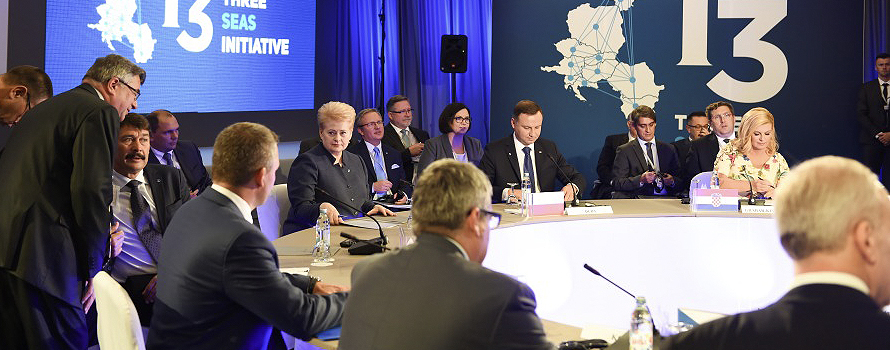
▲First meeting of the new forum, in the Croatian city of Dubrovnik, in August 2016 [i3].
article / Paula Ulibarrena
What is it and what does it aim to achieve?
It is an initiative of Poland and Croatia that brings together 12 countries located between the Baltic, Adriatic and Black Seas and is therefore also known as the Baltic, Adriatic, Black Sea (BABS) Initiative.
The key goal is promote that these countries of the European Union have greater cooperation in infrastructure development , economic development , economic cooperation and above all in energy resources. Polish President Andrzej Duda expressed the hope that the Three Seas Initiative would contribute to the modernisation, integration and unification of Central Europe, Eastern Europe and the entire European Union.
How and where was this forum born?
Since the fall of the Berlin Wall, much progress has been made towards a united, free and peaceful Europe. The entrance of Central European countries in the European Union and NATO has contributed to the security, stability and prosperity of the entire continent. But this work is far from complete. And the cohesive role of infrastructure will be crucial in achieving this.
For more than half a century, efforts to develop European connections and infrastructure focused on the East-West axis. After the fall of the Wall, governments in the region focused on integrating their economies into Western markets, leaving the development of a North-South interregional infrastructure on the back burner. After decades of disinvestment, a major effort has been made in the last twenty years to catch up: 5,600 kilometres of motorway have been built. But the imbalance between the two Europes is still glaring: a citizen of old Europe has twice as many kilometres of motorway as a citizen of central Europe, average.
|
▲Wikimedia Commons [JayCoop]. |
goal With the aim of reversing status, the presidents of Poland and Croatia, Andrzej Duda and Kolinda Grabar-Kitarović, respectively, launched in 2015 a project for the construction of energy, transport and telecommunications infrastructure in Central Europe. They called it the Three Seas Initiative.
By whom is it formed?
The initiative aims to modernise economic links between the twelve EU nations located between the Baltic, the Black Sea and the Adriatic Sea (Austria, Bulgaria, Croatia, the Czech Republic, Estonia, Hungary, Latvia, Lithuania, Poland, Romania, Slovakia and Slovenia). This region accounts for 28% of the European Union's territory and 22% of its population. But it accounts for only 10% of its GDP.
In 2016, Poland and Croatia were joined by most Eastern European countries: Austria, Bulgaria, Slovakia, Slovenia, Estonia, Hungary, Latvia, Lithuania, Czech Republic and Romania. Thus a north-south axis that, with the exception of Austria, corresponds to the former communist countries.
The so-called Three Seas Initiative held its first session on 25-26 August 2016 in Dubrovnik and ended with a declaration of cooperation on subject economic cooperation, particularly in the fields of energy, transport and communications. In addition to the member states, representatives of the Chinese Ministry of Foreign Affairs and the US Homeland Security committee attended as guests.
The second meeting took place on 6-7 July 2017 in Warsaw, with US President Donald Trump as a guest. In fact, this visit was a slight snub to other EU countries.
The third meeting will take place in Romania in 2018, although the city has not yet been fixed.
How is it financed?
150 billion from the Structural Funds, plus additional money from the Connecting Europe Facility and the European Investment Bank. However, more than 384 billion still needs to be invested in another 2,000 projects to fill in or modernise these corridors.
An investment of this size is beyond the possibilities of public institutions, so infrastructure companies and financial institutions will have to play a key role. Up to now, this subject of financing has been much less important than state contributions. However, the increase in public debt makes it increasingly interesting to have sources that minimise the impact on public accounts.
Screening
Faced with this magnitude of resource requirements, the question arises as to whether Central Europe is really an attractive market for investment. In this respect, two points can be made. This is a region with, firstly, very good economic growth prospects (expected to outpace Old Europe over the next five years), and secondly, with a construction sector that is expected to grow at a rate of 3.1% per annum average (compared to 2.3% for Western Europe), according to data by BMI Research. This is certainly attractive for investors.
The other side of the story is that we are still an emerging region. And, of course, this, in addition to generating reserves, brings with it a higher level of risk. In this sense, we also have very different situations depending on which country in the region we are looking at. For example, Estonia right now is what investors call a "sweet spot", with very high returns and low risk. But it is the only country in the region in this category. There are countries - such as Lithuania, Croatia, Slovakia and Slovenia - where the risks are equivalent to those of Greece or Italy, but the returns are relatively low. And others have the opposite problem: high returns but too much risk.
The experience of those players already present in this area -some of them Spanish, such as Ferrovial, Bankia or BBVA-, shows that although each country has significant peculiarities, there are some common risks. To mention them briefly: lack of political support; regulatory regimes that lack transparency; very complex contracting processes - such as PPPs and concessions -; lack of projects with the necessary level of maturity to arouse investor appetite, and the lack of skill in the public sector in these countries to take advantage of private-sector funding schemes, among others.
In an increasingly competitive and global Economics , the prosperity and well-being of a united Europe will depend on how quickly it adapts to today's world. In that process, building a connected, safe, affordable and sustainable transport network connecting the EU from north to south is core topic. Doing so will have a direct impact on increasing the competitiveness of all European countries, and consequently on the economic growth of Europe as a whole.
DOC. DE work / Iñigo González Inchaurraga
SUMMARY
The main, though not the only, element of contention between the United States and China is Taiwan. While Washington maintains a one-China policy, Beijing defends the "one China" principle, proclaiming that there is only one China in the world and that both the island of Taiwan and the mainland are the same People's Republic of China. The Chinese authorities also maintain that Chinese sovereignty and territory cannot be divided. In Beijing's eyes, Taiwan is a renegade province that emerged from the Chinese civil war, so reunification is the only option for the island's future. This reunification should preferably take place peacefully, but the use of force cannot be ruled out if Taiwan were to seek de jure independence. For its part, the government of Taipei claims its status as a sovereign state. The fact is that at the end of the 2010s, it is difficult to continue asking China to comply with international law in relation, for example, to the Permanent Court of Arbitration ruling and territorial disputes in the South China Sea, while Taiwan remains an anomaly that violates the same international law that Beijing must comply with in accordance with UN rules on the Law of the Sea.
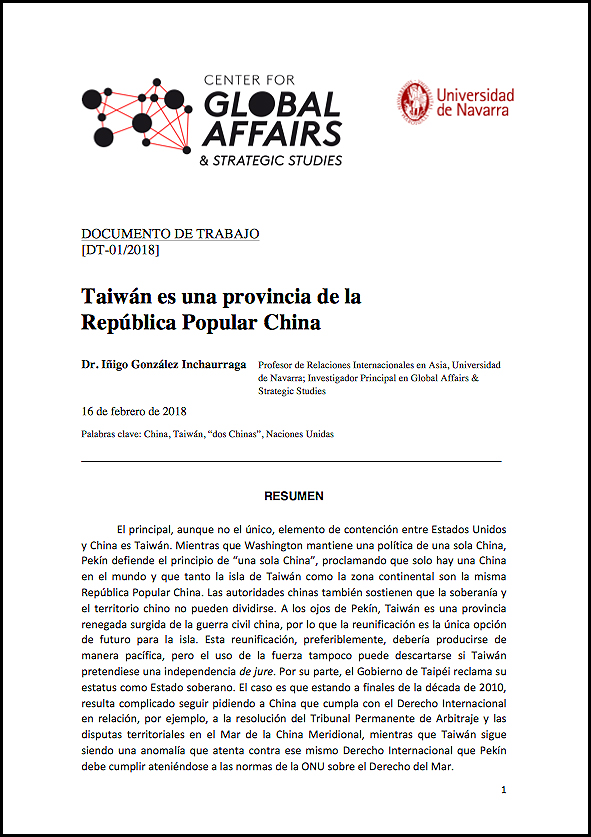 download the complete document [pdf. 432k]
download the complete document [pdf. 432k]
U.S.-China relations do not satisfy either country; They probably never will. They must try to deal with them, peacefully
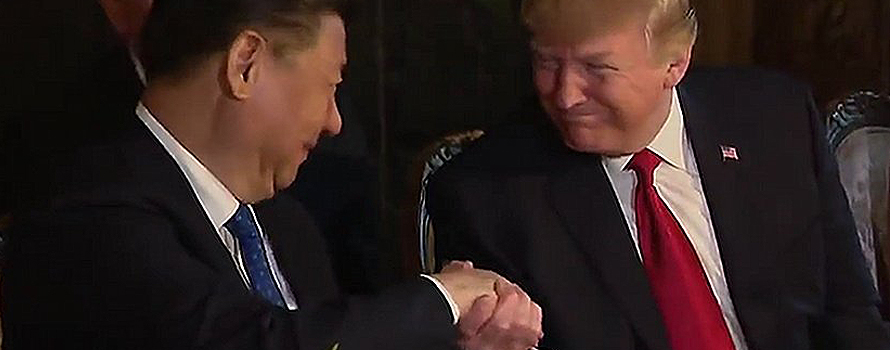
▲meeting between Xi Jinping and Donald Trump [White House video screebshot]
ANALYSIS / María Granados
The National Security Strategy presented in December by Donald Trump label China and Russia as "rivals" of the United States. It portrays those two countries as actors that "challenge the power, influence, and interests" of Washington and "attempt to erode the security and prosperity" of Americans. Although the document also considers "renegade" states such as Iran and North Korea, and transnational organizations, both jihadist and organized crime, a threat, the arguments of the new US administration are especially focused on China. The Asian nation appears as the great obstacle to the realization of the "America First" promised by Trump, because of its unfair trade and monetary practices.
Thus, the first National Security Strategy document of the Trump era corroborates the speech which he had maintained as candidate. During the election campaign, Trump spoke of China as a "currency manipulator" and accused it of artificially keeping the yuan low. He also threatened Beijing with starting a trade war, complaining about the economic consequences for the U.S. of China's excessive trade surplus in bilateral relations, as well as the reduction of jobs in U.S. manufacturing. Shortly after being elected, before the inauguration of his term, Trump provoked a diplomatic friction with China by talking by phone with the president of Taiwan.
However, since his arrival in the White House, Trump has been concerned with ironing out those rough edges with China. He pledged to uphold the One China Policy, retracted his criticisms, and met in Florida with President Xi Jinping, agreeing to respect each other's sphere of influence and not intervene in each other's internal affairs. This, along with an incipient partnership in the sanctions against North Korea, it seemed to be giving birth to a rapprochement that has not yet materialized. In fact, the U.S. National Security Strategy's official "rival" treatment of China somewhat breaks with a long period of mutual acceptance that began in the 1970s.
Nixon's Opening
The United States and China started from serious antecedents: the Korean War (1950-1953), which pitted China and the USSR in the North against the American-backed South, of which the Vietnam War (1955-1975) was a collateral consequence; and the nuclear danger that began in 1949, the year in which the USSR carried out the first nuclear war. essay effective. For Washington, from an ideological and military point of view, China was an international actor that should be controlled. For Beijing, in alliance with the Soviet Union, it was urgent to spread the speech communism about the "imperialist enemy," which he repeated with intensity throughout the early years of the Cold War.
In 1969, the new U.S. president, Richard Nixon, included in his speech inauguration of mandate one reference letter against isolationism (1). From the other side of the world there were also new messages: the distance that Mao began to establish in relation to the USSR due to its border conflicts. This upset the triangle of international relations that existed in those years of the Cold War (China, USSR, USA), and began to create a bond between Beijing and Washington.
In this way, the first signs of approximation began to appear. In 1971, the U.S. voted to allow Taiwan to join the committee of the United Nations Security Council will be occupied by the People's Republic of China. In 1972 the statement of Shanghai, which established the instructions for the Sino-American rapprochement and which was embodied in five principles:
1. The One China Policy: Establishing diplomatic relations with China meant not being able to establish them with Taiwan, and vice versa, since both claim to be the true and only China.
2. Not supporting Taiwan independence.
3. Do not support the possible invasion of Japan.
4. The peaceful resolution of the conflict with Taiwan, reducing military installations on the island.
5. A commitment to continue to be peaceful allies in the pursuit of lasting cooperation.
Since the rapprochement of the 1970s, relations between the two countries have been heavily influenced by Washington and Beijing's attitude toward Taiwan and the two Koreas, in a sort of indirect Sino-American relations.
|
▲meeting bilateral meeting at Mar-a-Lago, Florida, in April 2017 [White House] |
The Question of Taiwan
The self-styled Republic of China had been the main obstacle to the complete normalization of relations, as seen with the statement of Shanghai. Effective reunification by (mainland) China was prevented by U.S. troops.
After 1973 we find two important documents: the so-called Taiwan Relations Act, by which the United States recognized the island as before, but not that it was a sovereign nation, and the Taiwan Relations Act. statement Set (sometimes referred to as "Second statement of Shanghai"), drastically cutting arms sales to Taiwan. In 1979, Washington and Beijing exchanged ambassadors, and the Americans ceased formal diplomatic relations with Taiwan.
Around 1980, the policy advocated by the mainland Chinese government was "one country, two systems", offering Formosa the exceptionality of a different and economically independent political system, but being part of the one China. However, this formula did not meet the wishes of the twenty-third province for independence. By 1985, the island's government was firmly moving towards democracy (2).
In the late 1990s, Beijing threatened Taiwan with military exercises in surrounding waters, in which missiles were deployed, prompting a forceful response from the United States: sending two aircraft carrier battle groups to the region; In doing so, Washington showed a clear determination to protect the former ally because of its strategic importance.
The status The current situation remains complex. No direct ties have been established between China and its rebel province through messaging or telecommunications; Neither are postal or parcel shipments sent, nor is there a direct connection of flights. Face-to-face meetings between delegates have been infrequent and not very productive.
The North Korea Problem
The Democratic People's Republic of Korea, for its part, is a particularly critical point in Sino-American relations, which also affects South Korea and Japan, which in turn are allies of the United States. Pyongyang has already carried out six underground nuclear tests and continues its missile launches over the Sea of Japan.
China is North Korea's only ally: it is its biggest partner commercial and its main source of food and energy. Beijing has historically opposed tough international sanctions against its neighbor. The will to survive communism is essential when it comes to understanding the close relationship between the sui generis Korean dictatorship and China. It's easy to guess why: if Kim Jong-Un's regime falls, Xi Jinping's could be destabilized. A refugee crisis, with thousands of North Koreans crossing the 1,400-kilometer border bordering the two countries, would have serious effects on the Asian giant. Although they remain strongly linked to Pyongyang, the Chinese have pushed for the resumption of the Six Dialogue and have accepted the application of certain international sanctions.
Trump's blunt assertion that "if China isn't going to solve the North Korea problem, we will" doesn't really dispel doubts about what might happen if Pyongyang crosses the threshold of nuclear capability. Certainly, as the Kim Jong-Un regime has approached that threshold, Beijing has increased its diplomatic, financial and commercial pressures on its neighbor (3). But the possibility that North Korea is already on the verge of reaching its goal The strategic strategy leaves the United States faced with the dilemma of military action, which can hardly be both effective and limited, or having to settle for a policy of containment.
Over the years, Washington has tried to encourage North Korea to irreversibly forget its nuclear program, proposing in return a reward consisting of financial aid, diplomatic advantages and the normalization of relations. At the same time, South Korea hosts 29,000 U.S. military personnel. In March 2017, executive orders from the President and the congress The U.S. government went beyond sanctions: a defense system known as THAAD (Terminal High Altitude Area Defense) (4) was programmed as a preventive measure against a possible attack by the North and with the aim of protecting the environment. goal to ensure the stability of the region.
The THAAD battery is particularly interesting to analyze, because of the double perspective it presents. Their limited range and capability should not worry China, as the interceptors would not be able to hit Chinese intercontinental ballistic missiles at any point in their trajectory, from almost any of the possible launch locations. As such, neither Washington nor Seoul should present the system as a form of retaliation against Beijing for its failed sanctions on North Korea. Unfortunately, U.S. and South Korean officials suggest that the purpose of the installation of the THADD system is to send a warning message to China. This is somewhat counterproductive, since it only offers reasons to justify the nuclearization of the Asian hegemon, in the face of the apparent degradation of its medium-range technology, that of the second Degree nuclear response (second-strike capability).
Mutual dissatisfactions
If the issues of Taiwan and North Korea have occupied a large part of the diary In the bilateral relationship, the issue of China's economic transformation, since its impetus by Deng Xiaoping, has been central to the direct relationship between China and the United States.
Gǎigé kāifàng (reform and opening-up) emphasized modernization and economic and political reform. This led to normalized diplomatic relations and thedevelopment bilateral trade and investment. Cooperation in subject The political, economic and security relations with the former "American imperialists" were based on the prevention of terrorism and the proliferation of nuclear weapons, and the maintenance of peace on the Korean peninsula.
However, there are still unresolved issues. U.S. dissatisfaction stems from China's human rights policy and its financial moves to devalue the currency as a measure to control inflation. These monetary movements call into question the control of the market by the American hegemon, which currently has greater weight and primacy, among other things, because the dollar is the international currency of exchange (it could thus "export its inflation" to Beijing). Washington is also concerned about the U.S.'s dependence on imports from China, which creates a large bilateral trade deficit for Americans. Another potential problem is the sale of missiles and nuclear technology to third States in the Middle East and Asia.
From the Chinese perspective, their dissatisfaction is due to the U.S. arms sales to the rebel province (Taiwan), the defense system established in South Korea (both the THAAD system and the U.S. government). financial aid and a U.S. foreign policy that Beijing dismisses as threatening, imperialist and domineering.
Ways of cooperation
The U.S. consideration of China as a "rival," as stated in the Trump Administration's first National Defense Strategy document, is based on the realization that the Chinese regime is not moving towards democracy as many in the rest of the world had hoped. "For decades, U.S. policy was based on the belief that support for China's rise and its integration into the post-war international order would liberalize China," the document says, noting that Beijing is not sliding toward a regime of political freedoms and respect for human rights, so Washington can no longer be as condescending to Beijing as it once was.
Probably, without China's assumption of the values and principles that give meaning to the United States, a real and confident rapprochement between the two superpowers is impossible. Still, for the survival of both, broad cooperation between them is necessary.
Although a war between the United States and China is not impossible, it is unlikely for a number of reasons, as Steinberg and O'Hanlon argue in Strategic Reassurance and Resolve (2015):
–The common objectives of economic prosperity, the exchange In terms of trade, interdependence, both at the stock market, financial and business levels, make a military confrontation very harmful to both countries. In addition, China has progressively adopted measures against fraud and destabilization by computer manipulation, at the behest of the United States; The issue of cyberespionage, although it continues to provoke mutual disagreements, is regularly addressed by both countries in their bilateral meetings, aware that it is likely to become more important over the years.
The South China Sea is a trade route that has never been closed, although it is a source of dispute to be taken into account, since they remain unresolved even though they have been brought before the Court dealing with the Law of the Sea (following the United Nations Convention on the Sea). The United States has strategic and commercial interests in the region that link it to its allies (Japan and South Korea), so it could be a source of tensions. In any case, it does not currently appear that China wishes to provoke a military escalation in the area, although it has established instructions on artificial islands and moved troops.
The ASEAN code of conduct for the South China Sea, which prevents the use of force, may cause Beijing to rethink increasing its aggressiveness in the region. That push by ASEAN for China to stop claiming maritime sovereignty that has been rejected by the international community are points against the war.
There are a number of joint counter-terrorism (ISIS) and anti-piracy operations involving the two superpowers.
China has increased its financial aid and its work in support of UN peacekeeping missions.
Faced with a scenario of no understanding between Beijing and Washington, but at the same time of no armed confrontation, the following actions should be suggested:
A negotiation that would include fewer arms sales to Taiwan by the US in exchange for greater security on the coasts, and a proportional reduction by China of threats to the island.
–Greater cooperation and transparency in the conduct of arms and troop movements, militarization, restructuring of the armed forces, and military exercises in the Pacific.
–Creation of joint organisations to combat organised crime and cyber-attacks, in particular threats to civilian infrastructure.
- Support and coherence in the prevention of nuclear escalation. Negotiation to reach a firm conclusion on how to weaken the Pyongyang regime. Serious and coherent criticism, knowing the impossibility (as well as harm) of its direct overthrow.
-----------------------------------------
(1) "We seek an open world--open to ideas, open to the exchange of goods and people--a world in which no people, great or small, will live in angry isolation.
We cannot expect to make everyone our friend, but we can try to make no one our enemy". Inaugural Adress (January 20, 1969)
(2) It was the first time that the Democratic Progressive Party succeeded in pressing the elections to the National Assembly and the Legislative Yuan and forming a unified coalition against the Kuomintang. In 1992, the first free legislative elections were held in Taiwan.
(3) "China will be most likely to put diplomatic and financial pressure on North Korea if it believes that failing to do so will lead the United States to destabilize the regime," write Joshua Stanton, Sung- Yoon Lee, and Bruce Klingner in Foreign Affairs.
(4) The system typically has between 48 and 62 interceptor missiles with ranges of up to 200 kilometers, supported by radar with a range of up to about 1,000 kilometers
Showing the range 381 - 390 of 426 results.

